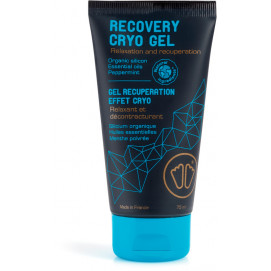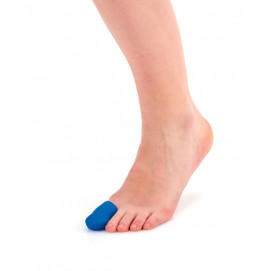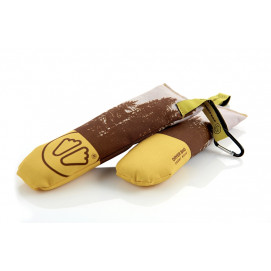 The feet after a marathon Read more
The feet after a marathon Read more How do I optimize foot recovery after a race?

Running is first and foremost about enjoyment. To keep it that way, it is absolutely necessary to pay particular attention a runner's key asset: his feet.
Here are some tips and tricks to take care of your feet and optimize recovery after the demands of a marathon or trail run.
A THREE-PHASE RECOVERY
We divided these recommendations into three stages :
- Right after crossing the finish line, the dossard still pinned on your t-shirt
- As soon as you get home, after a good shower
- In the days following the race, while your legs are still quite sore
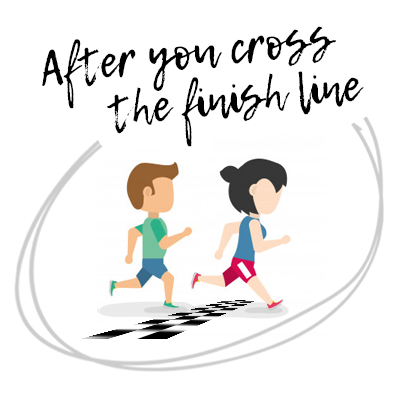
CONSCIENTIOUSLY PREPARING A POST-RACE BAG
1. TREAT THE PAIN TOENAILS AND BLISTERS RIGHT AWAY
Bruised nails and blisters are a common problem for runners. While most of the time these inconveniences remain mild and disappear within days, they can sometimes be much more troublesome. Marie Maligorne, head of the Sidas podiatry center, therefore recommends precaution, "making use of the health professionals present when you cross the finish line to pop a blister or drain a painful bruised toenail." She also points out that "practicing self-medication afterwards presents a very high risk of infection, especially when feet are dirty and tired from the effort...".
To avoid this unpleasant little detour at the end of the race, we have developed solutions that help prevent these inconveniences: a wide range of soles adapted to your running style, first of all, but also Silitene foot covers or gel toe caps
2. CONSCIENTIOUSLY PREPARING A POST-RACE BAG
Post-race recovery involves preparing your bag before the race. In fact, the best thing for your feet is to remove your shoes and give them fresh air with sandals or flip-flops that you’ll be thrilled to put on after you finish the race.
There are two options in this regard:
3. WALK SLOWLY BUT STEADILY
Once you have the right footwear on and your feet are in the open air, Marion Delespierre, a doctor of sports medicine and a top trainer, recommends "walking slowly, but steadily." She adds: "Walking, if only a little, is much better for recovery than staying on the couch. Indeed, this promotes venous return via a pump effect. This helps to drain lactic acid and properly irrigate foot muscles."
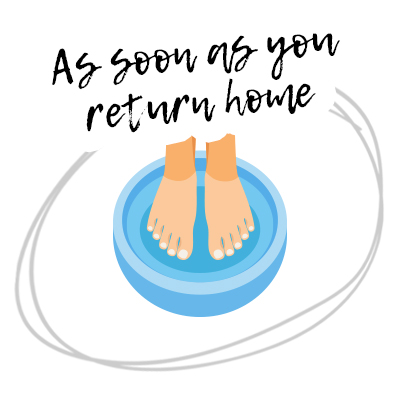
AS SOON AS YOU RETURN HOME
1. CLEAN YOUR FEET
The post-race shower is definitely the most pleasant part of a weekend spent running. It's practically a Holy Grail. Be sure to soak, rinse and dry your feet. Marion Delespierre adds: "Don’t hesitate to pass the sponge between your toes because a moist, tired foot is the perfect place for athlete's foot to appear."
2. WEAR COMPRESSION SOCKS
Once you've showered and refreshed yourself, after letting your feet dry for a while in the open air, it's that joyous time to put on your compression socks. Clément Scalliet, a sports physiotherapist, insists: "Use socks instead of plain sleeves because they exert effective compression on the whole lower limb, at least from the foot to the knee, without the risk of squeezing the ankle."
3. TAKE A NAP WITH YOUR LEGS RAISED
During the healthy nap that will surely take place in the afternoon after your race, it is a good idea to slip a pillow under your mattress or fall asleep with your legs raised. Once again, the purpose is to promote venous return and, thus, optimize recovery with the help of gravity.
4. ALTERNATE BETWEEN HOT AND COLD BATHS
Clément Scalliet, himself a frequent trail runner of distances over 40 km, shares one of his tips for giving his feet special care: "Alternating between hot and cold baths is a foolproof solution to get rid of the toxins built up while running!" Why? "Because it allows you to combine vasodilation and vasoconstriction." This means contracting blood vessels with the cold and then relaxing them to speed up circulation with the heat.
5. STRETCH YOUR FEET
Once you've rested, if you have any energy left, it's a good idea to stretch. "Not the foot's inherent muscles, rather all the anterior and posterior muscles that connect to it, Especially the calves!" advises Marie Maligorne.
6. MASSAGE YOUR ARCH WITH A GOLF BALL
If your foot muscles are very hard to stretch, there is a sure-fire way to give them some relief. Clément Scalliet shares his secret: "While seated, roll a ball back and forth in a circular motion for five minutes under each foot." He also suggests "using a golf ball instead of a tennis ball because it's smaller and more firm, which allows for a deeper transverse massage of the plantar aponeurosis and the adipose tissue."
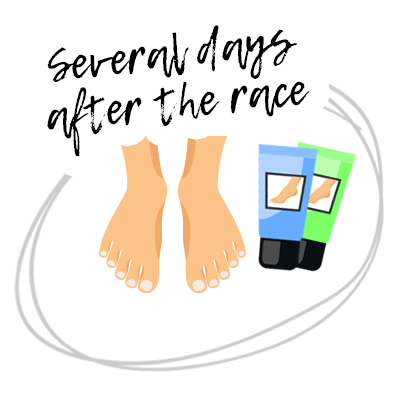
SEVERAL DAYS AFTER THE RACE
1. REHYDRATE YOUR FEET
After a race, the body is inevitably exhausted and dehydrated. "Dehydration can affect your feet. When very dry, your feet can be prone to painful cracking," notes Marion Delespierre, doctor of sports medicine. To protect herself from this unpleasant phenomenon, she recommends "applying moisturizing cream after showering for the first four or five days after the competition." A healthy gesture that also promotes well-being, optimized with our Cryo gel
2. SEE YOUR CHIROPRACTOR
Even if your legs are still sore, taking some additional steps, including seeing a chiropractor, can be beneficial. Marie Maligorne adds: "In a long, physically demanding competition, you run as well as you can, not as well as you want. This is where, because of fatigue, the runner may try to compensate and inadvertently adopt a bad posture or develop a joint blockage." A small check-up at the chiropractor, as a preventive measure, to return to training in good shape, is a welcome idea. There's nothing like a smooth, gradual recovery!
3. OPTIMIZE RECOVERY OF YOUR FEET BUT ALSO YOUR SHOES
Finally, if optimizing recovery of your feet is fundamental, maximizing recovery of your shoes is just as fundamental. Here's the protocol to follow: Remove the orthopedic sole or lining, then rinse the whole shoe with clear water. Do not use a washing machine. The expert podiatrist continues: "The life span of a shoe varies between 1,200 and 1,500 km. So if a race is the goal of a long training period, you’ll have every incentive to change out your pair of sneakers and get another pair for your next goal." Careful, though, changing them out does not necessarily mean throwing them away!
One last trick to extend the life of your shoes and keep them in good shape over the long term is to clean and rinse them, and then dry them as quickly as possible, out of the sun, using one of our many shoe driers (all natural cedar or electronic)


